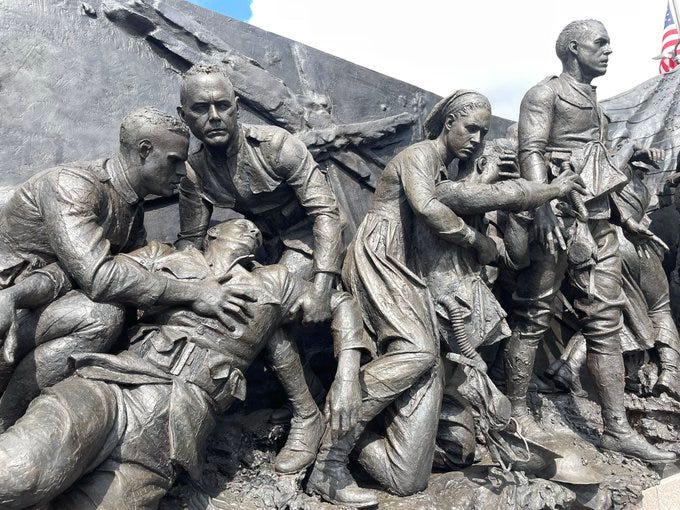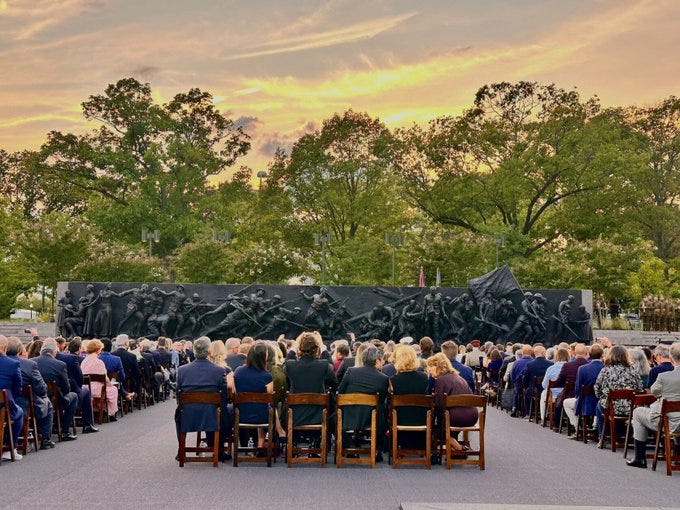Bridging Joy and Empathy Over Nihilism
A Reflection on Postmodern Art and What It Will Take to Replace It
Sometimes I feel an unbearable sadness for humanity, especially from my artistic perspective, seeing the abuse and the projection of psychotically low self-esteem. It’s not that I object to artists being hobbyists, or even projecting their hatred through art. But when incompetence, self-hatred, and a deeply disturbing spiritual fraud are celebrated as a high point of artistic achievement—that’s a sickness so vast and widespread that I don’t see how anyone can come away unscathed.
Tracey Emin came to prominence in 1999 for her bodily fluid-soiled, unmade bed, which was shortlisted for the Turner Prize. The shocking part wasn’t the juvenile, trite, self-deprecating prank, but rather that it was held up as high art. Now, after two and a half decades, we see the same kind of pathetic display in her retrospective show at the White Cube-London, one of the elite first-tier galleries in the world. The highlight of the upcoming show is a massive bronze sculpture that resembles a bumpy turd. In the video, we see it being unwrapped and placed on location, and discover that it’s a partial nude figure in a receiving posture, with its butt upright, while the head and chest are unrecognizable blobs.
Installing Tracy Emin’s sculpture at White Cube.
It might be giving her way too much credit, but I see a parallel between Marcel Duchamp’s Fountain—where art is something you piss on—and her sculpture, where art is something you f*** over.
An interesting phenomenon in art is that when you combine extraordinary mastery with erotic content, the two merge to evoke a feeling of physical love. But when you combine pathetic artistic incompetence with anything erotic, it devolves into degradation that strips away all dignity—like witnessing hollow, living-corpses copulating in a meth addict’s trap house. It’s a projection of despair, disintegration, and hopelessness. The spiritual theme of this sculpture is disgust.
White Cube is one of the world's leading contemporary art galleries, with spaces in London, New York, Hong Kong, Paris, and Seoul. It is also part of a network that includes international contemporary art museums, where artists gain aesthetic recognition. Art is one of the least objectively financially validated fields, and critical recognition by museums is extraordinarily instrumental in assigning financial value to it. This system also involves the interplay of government assistance with the so-called private sector. In a search of one of the museums associated with White Cube, Kunstmuseum Stuttgart, I could not find a listing of the trustees, board members, or funding sources, undoubtedly obscuring the true motives behind the museum's agenda.
Could this network of galleries and museums serve as a PsyOp for a New World Order, where the concepts of independence, conviction, love, and hope—the values celebrated by humanist art—must be eradicated?
Despite the pervasive degradation among the art world elite, there are still beacons of hope and integrity that remind us of art’s true potential. Sabin Howard's recent monumental sculpture, a World War I memorial, stands as a powerful testament to epic technical accomplishment and a passionate ode to human struggle, endurance, love, and care.
Sabin Howard, The Soldier's Journey, 2024, bronze, Washington D. C.
In my artistic journey, I have always sought to create works that represent the overarching joy that I have felt since I was a child. My grandmother once lamented that she hoped I would find the joy in the world that would match my own. I have lived with the psychological horrors of postmodern art on a daily basis for over 50 years. I owe a debt of gratitude to my mom, who instilled in me the belief that I should always bring about a successful resolution to everything I did. This quality for a fulfilling end is amplified in my ongoing monumental series, The Space Series.
I remember the Eureka moment when I first envisioned this project: when I completed the painting Lady of the Lake, in which her figures' shadows were transparent. The granite mountains in the distance shone through her shoulders, and the lake's water formed the center of her body. Her lower parts were made up of Earth and ground, while her head was celestial. When I realized the possibilities of making the transparent shadowed self the stuff of the universe—and that it would be the light that defines us—I saw how a monumental series of space gods and goddesses could be achieved, each celebrating their individual happiness—much like how I experience mine.
Newberry, Lady of the Lake, 2023, oil on linen, 48x48”.
I was to find out later that my expression of joy as an end in itself was a concept coined by Aristotle, known as eudaimonia. His concept is based on a moment of contemplation, reflecting on the good works one has done, and the joy of that experience is an end in itself—perhaps the greatest concept in all of human knowledge. I also discovered its antithesis, Immanuel Kant's view, where the sublime is nihilistic, formless, has no appeal to our appreciation of beauty, and violates our sense of reason. These two worldviews are not compatible: one leads to flourishing, and the other to human eradication.
For the last 75 years, the culture of nihilism and hatred for humanity has dominated the arts. The arts are symbolic, if not literally representative, of a culture's spirit, and even more so, the dominant arts represent where a culture is heading. I pray and hope that with hard work, dedication, tremendous creativity, and problem-solving, we can transplant the postmodern art world with a new and flourishing Renaissance.
Michael Newberry, Idyllwild, September 25, 2024
A Review of Sabin Howard’s Soldier’s Journey
On September 13th, 2024, Sabin Howard's World War I memorial, A Soldier's Journey, was unveiled in Washington D.C.'s Pershing Park. The 8-year project involved designers, government officials, organizations, and both government and private funding. But I want to concentrate just on the sculpture. The bronze high relief sculpture is 60 feet wide and about seven feet tall, with figures roughly 10% larger than life. It weighs 25 tons and features 38 figures, telling the story of a soldier’s journey—leaving his home and family to go to war, experiencing the loss of his comrades and the mental anguish, and finally returning home.
The Dreamgate
I have a vision for a site to permanently exhibit The Space Series, a collection of monumental figurative works of human gods and goddesses against a backdrop of the cosmos. The series represents aesthetic milestones: the realization of eudaimonia in art, revolutionary advancements in color and light theory, and the symbolic integration—showing that while our shadowed selves are transparent, it is the light that defines us.
A Little Video Survey of 50 Museum Shows Now (25-seconds)
This will give a good sense of what is going on in the contemporary art world.







Not only have you found your joy, but you radiate it through you arr and your writing. This is how we combat the nihilism - with true meaning and beauty wrenched from the soul. Thank you.
Your art-joy is contagious and uplifting. I have not seen “lady of the lake”; she is gorgeous! I love the way you’ve painted her hair, almost like a halo. I love that she was the stepping stone to your space series, how very cool the way inspiration strikes. This made me unreasonably sad:
“where the sublime is nihilistic, formless, has no appeal to our appreciation of beauty, and violates our sense of reason. “
I have stood in front of art works, sobbing my eyes out because of how beautiful they are. I wish that kind of joy on every human.